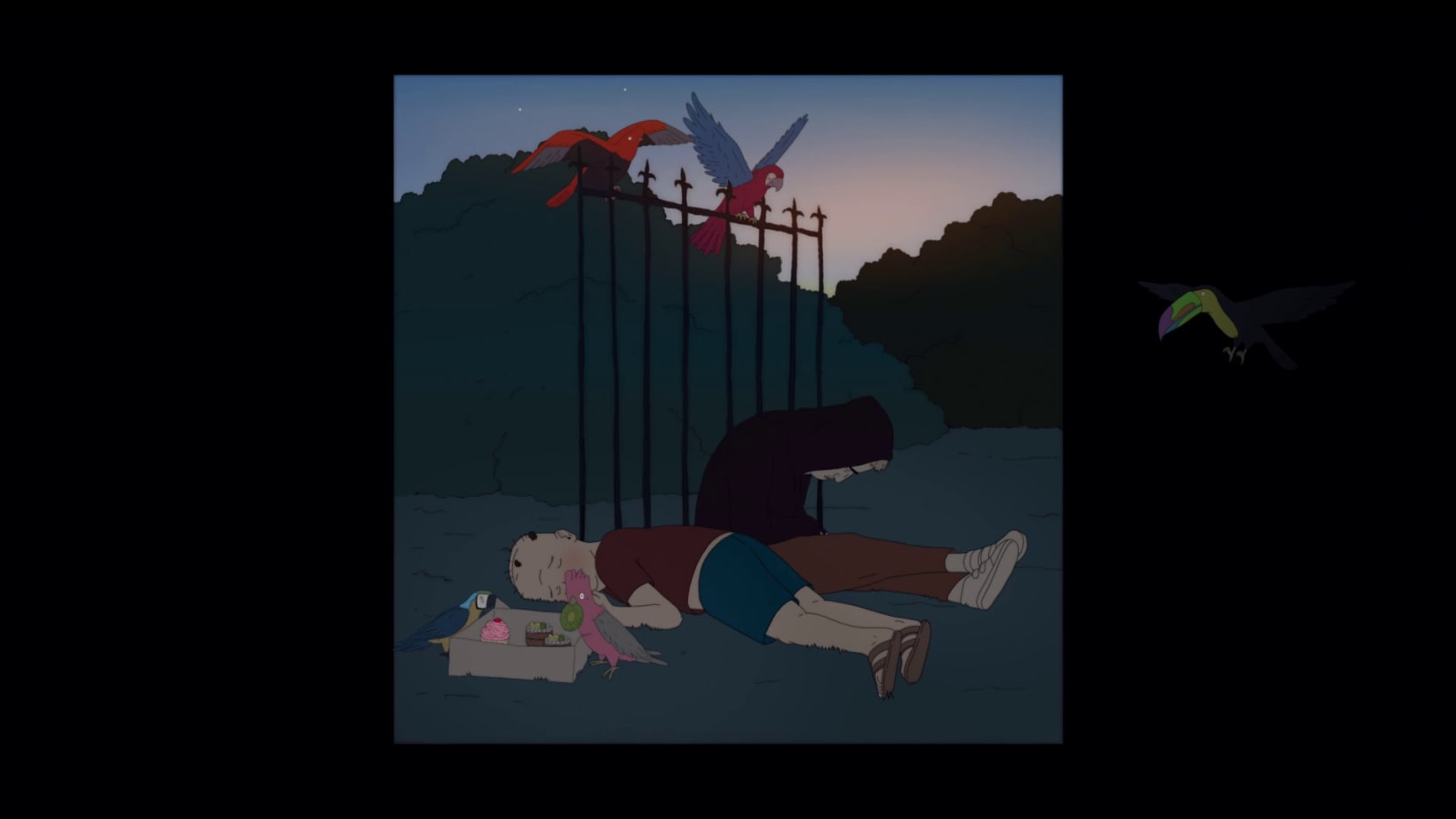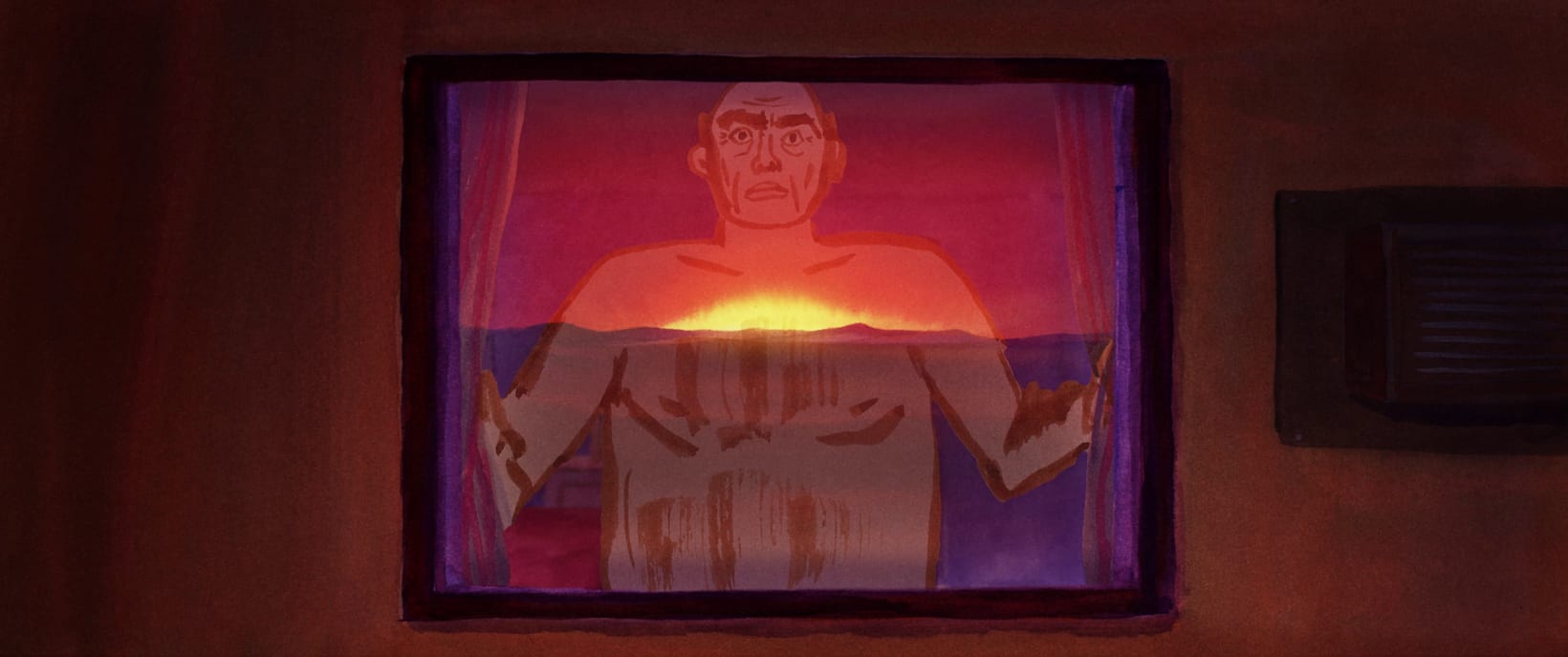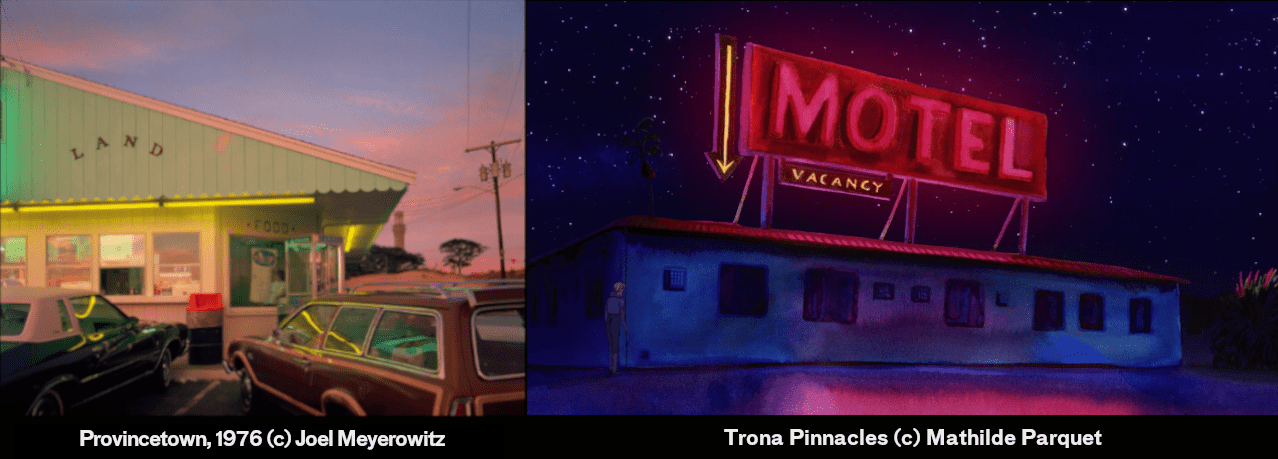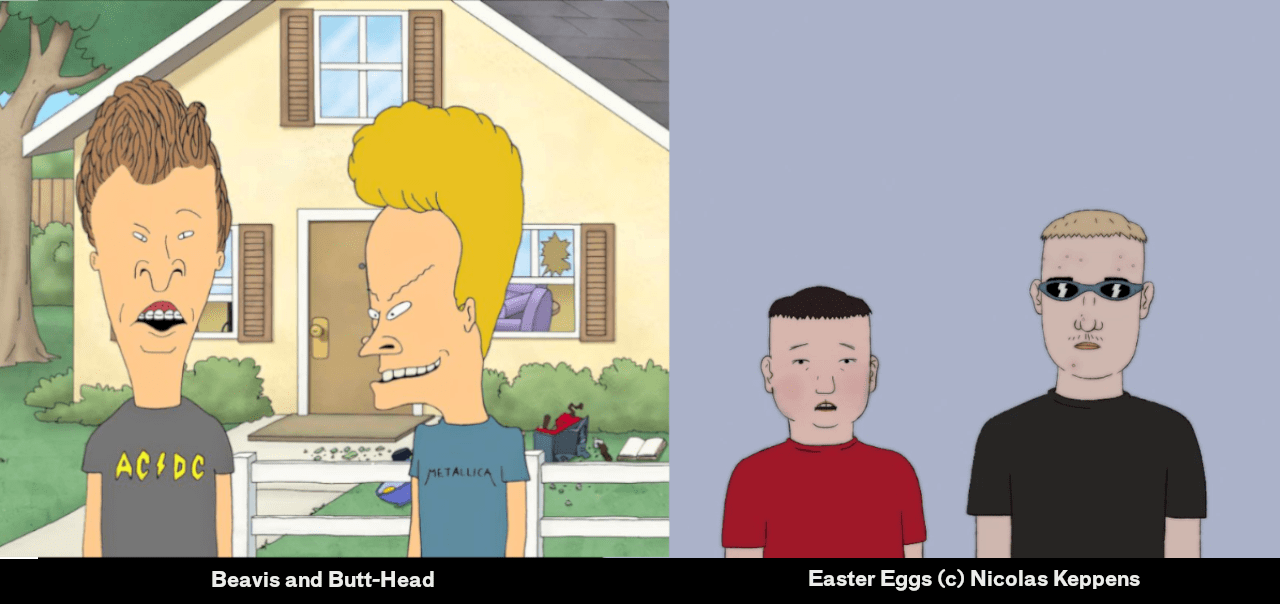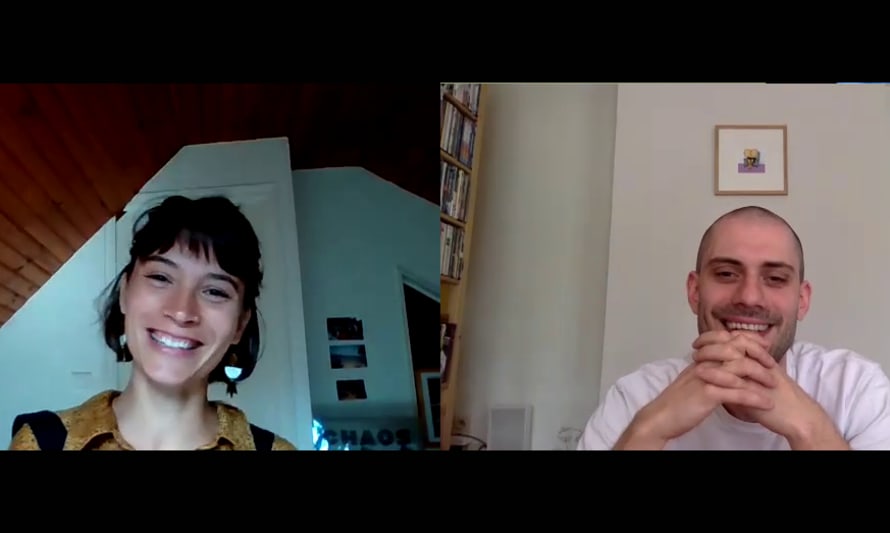
Mathilde Parquet & Nicolas Keppens in conversation
One of the many joys of organising a festival is to connect artists and let the magic happen. When we saw Mathilde Parquet and Nicolas Keppens' films, we thought they would have a lot to say to each other... And they did. The two talented animators - who are making a name for themselves on the short film scene - met online to discuss 90s animation, voice acting and sci-fi musicals.
This interview will be best enjoyed after watching the films:
To watch Nicolas and Mathilde's films, head over to our virtual festival. Easter Eggs and Trona Pinnacles are part of the Short Film Competition programme Late Night Tales, available from 26-28 May to viewers in the UK and Northern Ireland with a Short Film Pass or a Flatpass.
Nicolas Keppens (NK)- I first saw your film at Anima and really liked it, I was talking the other day with a friend who's making a project in the Death Valley. It struck me that she talked about things we see in your film - was it immediately clear to you that it should take place in the desert of California?
Mathilde Parquet (MP)- Yes, because it's directly inspired by my own experience - I made this trip with my family 10 years ago, and almost all the details are true. The day after that train incident, my mum told me "it's amazing, you have to make a film about it!". But it was a terrible trip and I didn't want to relive it. 6 or 7 years later I had to write a script for a school project and this idea came back to mind.
NK- When I saw the film there was no doubt for me that you were the girl in it. And at the end, you show this photo of your mother in front of the train, which is like telling the spectator "you were right"... In a way it made me sad, because the story is not the most hopeful!
MP- The main character is not me, it's my sister! For a long time I've asked myself if I should put this picture at the end, but I really like it. It shows not only my mother but also the train, which you could think is a thing I made up, when actually it really exists.
NK- What your mother does in the film is courageous. Watching the film you could think the parents are just lost, but with this picture you're saying: she moved a train for us! It changes our perception of the characters.
MP- I never thought about it this way! I really liked the atmosphere of your film too, the balance between the realistic dialogues and the strange details. Like the kid's house, this old middle-class house with cracks. Or the couple dancing in the living room who almost look like ghosts. Same with the fence in the middle of nowhere, which seems like like an absurd element...
NK- For the fence I was influenced by the film Gerry, by Gus Van Sant. There is a moment where one of the two Gerrys is on top of a big rock, you don't know how he got there, and he doesn't know how to get off. I really like this idea that one of the two Gerrys just messed up for no reason. I'm not a fan of films where everything has to have a logical explanation.
MP- Jason, the other character, has a big imagination, and at the end it's like we're with him, in his head, with all these birds flying around.
NK- The birds arrive from the black borders. They remain outside of the screen until both characters start believing in them. It's like looking for easter eggs, it works only if you believe in it. The moment you know your parents hide the easter eggs the day before, it seems absurd to do it. You have to believe in the birds for them to appear. When you believe that there is something hidden around the cinema screen, the story can start making sense.
MP- There's a lot of music in your film, which contributes to the strange atmosphere...
NK- I worked with a composer who used some of my influences, for instance Moondog, who made these strange childlike compositions. The Moondog music was a big inspiration for the character of Jason, you can hear this childlike tune with his voice over. I wanted to ask you about the horse in your film! It seemed like a moment where you left the anecdote aside to start developing a metaphor...
MP- It was really important for me have to each character alone at one point. The main character is the girl so I wanted to stay with her. My mother was like "it's a shame, if you want I can tell you what happened" but I said no! The story is very close to me but I didn't want the film be too realistic, I wanted to convey a feeling. When the girl goes out of the car it's the first time she's in the desert. The horse is not really the spirit of the place but let's say it contributes to its strangeness. It's a meeting between this girl and the place.
NK- One of my favourite shots in your film is the sunset in the reflection of the window, when the father closes the curtains. You show that sunset in the window and you ask the father and the spectator to see the beauty of it... I'm very jealous of your graphic design! The combination of old school techniques (like painting) with digital is something that is very dangerous to do.
MP- Graphic design is really hard. I like to draw from observation. For the backgrounds I take inspiration from painters like Emile Nolde, David Hockney. For this film the light was very difficult to get right. I worked early on in the process with Clément Coursier, who makes the compositing, to find the right balance between the different elements – handdrawn and digital.
NK- It seems like you did it very naturally, there were backgrounds in the films that made me think: "if you overthink this, you can't do this". I was wondering too - there isn't a lot of talking in the film, just enough. Did you record more than you needed and then edited the voices?
MP- I really wanted to ask you the same question! I wrote everything beforehand. The main character is voiced by my sister. I was afraid that Canal+ (who had pre-bought the film) wouldn't approve of this choice. Usually when you say "I want my family in the film!" people are like "hmm are you sure?". I think if Canal+ had said no, I couldn't have made the film, it had to be her. Luckily they thought she was perfect. During the recording, the other actors asked her a lot of questions about the real story behind the film, and she gave them a lot of details – at the end they even knew her nickname! I can do up to 15, 20 takes to get a scene right. It's a lot of work for just a few sentences.
NK- It's amazing that everything is scripted, it almost seems like you recorded the whole vacation and took out the bits you needed. Maybe because you added all this non-verbal communication...
MP- The film is all about non-communication. The communication between the parents is broken. It's a subject I'm generally interested in. I don't like when there's too much dialogue, or when the dialogues explain everything. What about you, is there a lot of improvisation? Do you work with confirmed actors?
NK- The actor who plays Jason was the main actor in the film Girl, about a young transgender dancer. Victor (Polster) was 17 at the time and because Girl was the only film he had done, he was used to acting with a soft, high-pitched voice. He's a very sweet, soft guy anyway. I did some rehearsals with him where I played Kevin, and I invented a lot of the dialogue then, all the bragging, the jokes. Afterwards we took Rick, a confirmed actor, to play Kevin. During the rehearsals with Victor, I rewrote the voice over. The first one I wrote was a bit more harsh and I didn't believe that Jason with the voice of Victor would tell the story like that. I wanted to ask you about your influences in cinema. You talked about painters, but your film uses so much cinematographic language...
MP- I see more live-action than animation films. Each time I make a film I want to see all the existing films about the subject. For this one I wanted to see films in the desert.
NK- There are a lot of them!
MP- I couldn't watch them all! But I discovered Bagdad Café, I rewatched Paris, Texas. They all seem to deal with the same subject : loneliness and the difficulty to connect with people. Desert is a character in itself.
NK- I thought about Paris, Texas when I saw the neon in the hotel. Robby Müller cinematography.
MP- For this I was inspired by a photographer, Joel Meyerowitz, who takes pictures of empty pools, lonely places... I like films that are more about the atmosphere than the story. I don't know if it's the same for you, but for me it was hard to sell this film because the script is very short. I want to tell a story through images, not words, and it's difficult when you're looking for funding.
NK- I can imagine your script is quite a short one! That's why I was wondering if you wrote more, because I wouldn't dare write a script that is so concise... Although you proved that you could make it work! For me it's the opposite, I always write more dialogues, voices, and then people tell me it's going in all directions.
MP- Can you talk about your choices for the animation in Easter Eggs?
NK- One day I saw a making of The White Ribbon by Michael Haneke. It's a black and white film taking place just before WWI, and he said that because all the documentation of that time was in black white, he couldn't help but imagine this period in black & white. Films set in the 17th century often look like 17th century paintings. As Easter Eggs is about my childhood, it had to look like the 90s animation I watched growing up – Beavis & Butthead, The Simpsons, King of the Hill, the 90s work of the Ghibli studio... That's why I chose these colours, these quirky characters. I asked the animators to evolve in complexity between the first scene and the last. Going from 2D to more depth. The first shot with the finger coming out of the table is a very naive shot, and the more the film evolves, the more we add details, the perspective starts changing... Every time I make a film I try to make the graphic design match what the story has to say.
MP- Are you working on another project at the moment?
NK- I'm working on a new short called Beautiful Men which is about 3 brothers going to Istanbul for a hair transplant. The backgrounds will be in 3D and the characters in 2D. I want them to look uneasy in their environment. I'm also trying (but that's a very long-term project) to make a feature film in stop motion. It's about story-telling, how we perceive other cultures. With stop motion, it's so clear in every shot that you're looking at a puppet, but you have to believe in it.
MP- I think we have a lot in common! Right now I'm working on a science fiction musical in stop motion. It's about a woman whose work is to listen to the sky to hear messages from aliens. She wants to know if there is someone else in the universe but loses the link to Earth, her family... It's about the difficulty to communicate (again!) and the difficulty to find a balance between your passion and your life. Same as when you're making films... You want to connect with other people through them, but it can be a very solitary process!
A huge thanks to Mathilde Parquet and Nicolas Keppens for their time and their fascinating and infectiously energetic conversation.

